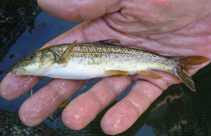http://www.fishbase.org/Summary/speciesSummary.php?genusname=Barbus&speciesname=carpathicus ---> http://52.67.158.155/Summary/speciesSummary.php?genusname=Barbus&speciesname=carpathicus
http://52.67.158.155/Summary/speciesSummary.php?genusname=Barbus&speciesname=carpathicus ---> https://fishbase.net.br/Summary/speciesSummary.php?genusname=Barbus&speciesname=carpathicus
https://fishbase.net.br/Summary/speciesSummary.php?genusname=Barbus&speciesname=carpathicus ---> https://fishbase.net.br/summary/Barbus-carpathicus.html
Barbus carpathicus

You can
sponsor
this page
Common name (e.g. trout)
Genus + Species (e.g. Gadus morhua)
-

-
About this page
-
Languages
-
User feedbacks
-
Citation
-
Uploads
-
Related species
-



Barbus
carpathicus
KotlÃk
,
Tsigenopoulos
,
Ráb
&
Berrebi
,
2002
Upload your
photos
and
videos
Pictures
|
Google image
 Barbus carpathicus
Barbus carpathicus
Picture by
Harka, A.
Teleostei (teleosts) >
Cypriniformes
(Carps) >
Cyprinidae
(Minnows or carps) > Barbinae
Etymology:
Barbus:
Latin, barbus = barbel (Ref.
45335
)
.
Environment: milieu / climate zone / depth range / distribution range
Ecology
Freshwater; benthopelagic. Temperate
Europe: Tisza system (Danube drainage), from Hron to SomeÅ sub-systems, occasionally reaching to eastern Austria; upper Vistula drainage in Slovakia and Poland; Wierzyca system (lower Vistula drainage, Poland); upper Dniestr drainage in Poland and Ukraine.
Length at first maturity / Size / Weight / Age
Maturity: L
m
12.5
, range 11 - 14 cm
Max length : 27.0 cm SL male/unsexed; (Ref.
59043
)
Short description
Morphology
|
Morphometrics
Differs from its congeners in Danube drainage and northern central Europe by having the following characters: last simple dorsal ray weak, not serrated posteriorly, segmented on its entire length; lower lip thick, with a median lobe; 8-11 scale rows between lateral line and dorsal origin; 8-9 rows of scales between lateral line and pelvic origin; top of head plain; cheek and opercle unspotted or with very few small spots; paired fins unspotted, rays unpigmented or with few dark pigments not forming dark bars; body plain with faint dots and blotches slightly darker than background; caudal fin unspotted or with spots smaller than pupil diameter. However, these characters may be of little use when differentiating this species from
Barbus balcanicus
and
Barbus petenyi
in the field as identification of
Barbus carpathicus
is based mainly on mtDNA characters (Ref.
59043
).
Inhabits fast to moderate flowing premontane and montane streams and small rivers with gravel bottom. Most abundantly found in shallow rapids and riffles during summer and moves to deeper places in winter. Larvae and juveniles live on the bottom in very shallow shoreline habitats and leave the shores for faster-flowing waters as they grow. Feeds on a wide variety of benthic vertebrates and algae. Spawns in fast-flowing water (0.8-1 m/s) of shallow riffles with depth 0.5-0.8 m (Ref.
59043
).
Life cycle and mating behavior
Maturity
|
Reproduction
|
Spawning
|
Eggs
|
Fecundity
|
Larvae
Kottelat, M. and J. Freyhof
, 2007. Handbook of European freshwater fishes. Publications Kottelat, Cornol and Freyhof, Berlin. 646 pp. (Ref.
59043
)
IUCN Red List Status (Ref.
130435
)
Least Concern (LC)
; Date assessed:
01 January 2008
CITES
Not Evaluated
Not Evaluated
Threat to humans
Harmless
Human uses
FAO - Publication:
search
|
FishSource
|
More information
Countries
FAO areas
Ecosystems
Occurrences
Introductions
Stocks
Ecology
Diet
Food items
Food consumption
Ration
Common names
Synonyms
Metabolism
Predators
Ecotoxicology
Reproduction
Maturity
Spawning
Spawning aggregation
Fecundity
Eggs
Egg development
Age/Size
Growth
Length-weight
Length-length
Length-frequencies
Morphometrics
Morphology
Larvae
Larval dynamics
Recruitment
Abundance
BRUVS
References
Aquaculture
Aquaculture profile
Strains
Genetics
Electrophoreses
Heritability
Diseases
Processing
Nutrients
Mass conversion
Collaborators
Pictures
Stamps, Coins Misc.
Sounds
Ciguatera
Speed
Swim. type
Gill area
Otoliths
Brains
Vision
Tools
E-book
|
Field guide
|
Length-frequency wizard
|
Life-history tool
|
Point map
|
Classification Tree
|
Catch-MSY
|
Special reports
Check for Aquarium maintenance
|
Check for Species Fact Sheets
|
Check for Aquaculture Fact Sheets
Download XML
Summary page
|
Point data
|
Common names
|
Photos
Internet sources
AFORO (otoliths) |
Aquatic Commons
|
BHL
|
Cloffa
|
BOLDSystems
|
Websites from users
|
Check FishWatcher
|
CISTI
|
Catalog of Fishes
:
genus
,
species
|
DiscoverLife
|
ECOTOX
| FAO - Publication:
search
|
Faunafri
| Fishipedia |
Fishtrace
| GenBank:
genome
,
nucleotide
| GloBI |
Google Books
|
Google Scholar
|
Google
| IGFA World Record |
MitoFish
|
Otolith Atlas of Taiwan Fishes
|
PubMed
| Reef Life Survey | Socotra Atlas |
Tree of Life
| Wikipedia:
Go
,
Search
| World Records Freshwater Fishing |
Zoobank
|
Zoological Record
Estimates based on models
Phylogenetic diversity index (Ref.
82804
): PD
50
= 0.5000 [Uniqueness, from 0.5 = low to 2.0 = high].
Bayesian length-weight: a=0.00676 (0.00347 - 0.01318), b=3.02 (2.85 - 3.19), in cm total length, based on LWR estimates for this (Sub)family-body shape (Ref.
93245
).
Trophic level (Ref.
69278
): 3.1 ±0.4 se; based on size and trophs of closest relatives
Resilience (Ref.
120179
): Medium, minimum population doubling time 1.4 - 4.4 years (Preliminary K or Fecundity.).
Fishing Vulnerability (Ref.
59153
): Low vulnerability (23 of 100).
Back to Search
Random Species
Back to Top
Accessed through:
Not available
FishBase mirror site :
Laguna, Philippines
Page last modified by :
mrius-barile
|